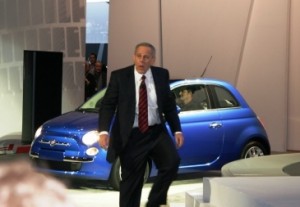
Just months after the automaker emerged from bankruptcy, Chrysler CEO Sergio Marchionne is predicting an operating profit in 2010.
Less than five months after emerging from bankruptcy, Chrysler Group LLC has laid out an aggressive turnaround plan that will, if successful, more than double its North American sales, restore most of the market share it has lost in recent years, finally position it as a serious global player – and generate as much as $14 billion in profits over the next five years.
During an all-day session that explored the minutia of a far-reaching turnaround plan, Chrysler’s new CEO Sergio Marchionne promised no miracles but insisted that even using conservative estimates for the recovery of the U.S. market, Chrysler could be back in the black on an operating basis next year, and turn a net profit in 2011.
In a message likely to be particularly well received by taxpayers worried about the $80 billion in money used to bailout Chrysler and General Motors, Marchionne said he expects to pay back the U.S. Treasury by the end of the 5-year bailout program.

Former Chrysler Vice Chairman Jim Press shows off the Fiat 500, which will become a critical part of the "new" Chrysler line-up.
Marchionne described the plan, hammered together in the months since Chrysler’s June emergence from Chapter 11 protection as “comprehensive, serious and…ambitious.” To underscore that point, he was joined onstage by 15 different senior executives, during eight hours of briefings to more than 300 reporters, analysts and other interested parties.
Among them was Ralph Gilles, who is serving dual roles as Chrysler Group’s design director and as the new general manager of the Dodge division. A self-proclaimed optimist, Gilles nonetheless began his comments by acknowledging the many mistakes Chrysler has made in recent years, which he described as “flawed visions, wasted haste and fumbled products.”
Various speakers pointed to quality problems – which last week led the influential Consumer Reports magazine to note, during the release of its annual auto reliability study, that Chrysler’s three brands were among the four lowest-ranked in the survey.
“We can’t expect to change our situation unless we change the way we work,” stressed Doug Betts, Chrysler’s new director of quality control, as he began outlining the way Chrysler plans to approach the problem. Among other things, various separate quality operations have been combined into one central unit. The group aims to eliminate the delays that in the past meant Chrysler would take as much as 71 days “doing absolutely nothing,” according to Betts, before it even looked into reports of quality problems.
Chrysler plans to hire new members for the quality control program, company executive notes, along with new engineers for product development. That will yield a 7% increase in the company’s staff, and a significant boost in contract workers, as well – a sharp turnaround from recent years during which Chrysler shed tens of thousands of jobs.
Under the turnaround plan, Chrysler will adopt the manufacturing system developed by Fiat, which gained control of the U.S. maker as part of its emergence from bankruptcy.
The two companies, meanwhile, will consolidate their product development programs to the point, said Marchionne, that 50% of the vehicles Chrysler sells, by 2014, will be based on Fiat platforms. And Fiat-designed powertrains, primarily diesels and small gasoline engines, will power 40% of the American maker’s product lines.
At the same time, Chrysler’s larger cars and trucks will fill in the gaps in Fiat’s own line-up, the Canadian-born executive stressed, helping make Fiat more successful around the world.
Among other things, Fiat will bring to the U.S. a Chrysler version of its popular 500 minicar, as well as a larger crossover vehicle and two commercial vans. (For a complete rundown of the transformation coming in Chrysler’s products, Click Here.) A few new products will launch in 2010, but the real transformation, accounting for 75% of the Chrysler line-up, will push into 2011.
Worrisome, said analyst Stephanie Brinley, of AutoPacific, Inc., since, “they’ll have to keep selling mostly the same Chrysler products they have now for the next 12 to 14 months.”
Another challenge is something beyond Chrysler’s control: the recovery of the U.S. market. But in outlining the anticipated recovery of the long-troubled company, Marchionne noted that Chrysler planners had relied on sales forecasts notably below the general industry consensus, giving them plenty of margin for error.
Nonetheless, there were some optimistic expectations laid out during the meeting, which was held inside the design dome where Chrysler officials routinely gather to review future product designs. For one thing, Marchionne’s plan calls for overall Chrysler sales to grow from 1.3 million units to 2.8 million by 2014, with market share rising from barely 8% to the low teens. But much of the improvement would be driven by a revival of the American market, which this year hit its lowest point since the early 1980s.
Significantly, Chrysler is also counting on boosting international sales from an estimated 182,000, this year, to 500,000 by the completion of the five-year plan.
Fiat has been unusually tight-lipped about its turnaround plan – something Marchionne suggested may have led to concern among consumers and may have led them to steer clear of Chrysler products, in recent months. The company reported a 30% decline in U.S. volume, during October, while Ford and GM posted gains.
Some details leaked out, but there were also numerous surprises, such as the decision to split off the pickup truck side of the Dodge division and create the new Ram brand. An advertising campaign, dubbed “I am Ram,” will begin promoting the shift this week.
Meanwhile, there was no mention, during the briefing, of the Alfa Romeo brand, the sporty Fiat division that the Italian maker has long sought to re-launch in the U.S. market. Pressed for an explanation during an evening question-and-answer session, Marchionne was vague, suggesting that he believes Alfa could sell as many as 70,000 vehicles in the U.S. in 2014, but that the brand must convince Chrysler planners that this justifies the commitment that would be needed to revive Alfa in the States.
Coming out of the bankruptcy process, Fiat was granted a 20% stake in Chrysler, but that will grow to 35% if the Italian maker hits a series of targets. Meanwhile, Marchionne said that the investment to bring Chrysler back to sustained profitability will total $23 billion by 2014.
Government officials have said they would like to shed their 10% stake in the company as soon as is reasonably possible. This could be done privately, though it might also be part of an Initial Public Offering that would again make Chrysler a publicly-traded corporation. That is “unlikely to occur earlier than 2011,” said Chief Financial Officer Richard Palmer.
The pledge to pay back taxpayers is something that won’t be easily forgotten, particularly considering the General Accounting Office, which serves as the independent research arm for Congress, concluded this week that the Treasury is not likely to get back the money it used to prop up Chrysler and GM.
Can Marchionne and Chrysler succeed in what the executive admitted was an “ambitious” plan? There were plenty of skeptics going into the Wednesday session, but a significant number of converts coming out that evening.
“Yes,” said Michael Jackson, the outspoken CEO of the nation’s largest auto retail chain, AutoNation, the plan “is credible. I’m a believer of the Chrysler story.”
